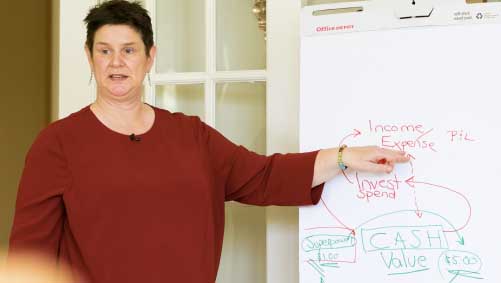
Today, we’re diving into the world of profit margins.
(Don’t worry; we’re going to keep it in plain, entrepreneur-friendly language.)
Why?
Because profit margins are the real measure of your business success, and it’s time to give them their deserved seat of honor.
All that bragging you hear from people with 7-figure businesses?
All that hoopla about the 2-comma club?
Well – here you go – I’m saying it: Alone, those statements and awards mean absolutely nothing about how successful a business is or how wealthy or brilliant an owner is.
There – I said it!
I know plenty of 7- and even 8-figure businesses who make absolutely no money after all of their expenses.
They’re in debt up to their ears, and for every dollar of revenue they make, they spend two dollars.
And that leaves them generating losses every single day.
So, the next time you hear someone say they have a 7-figure business, or you need to “make” at least $1,000,000 to be “in the room” –
Well, first of all, be pretty confident that it’s not a room you want to be in, because they don’t know much about business.
But second, ask them the follow-up question: “What’s your profit?”
Because guess what – both these businesses are 7-figure businesses:
Business 1:
$1.0 million REVENUE minus
$0.5 million EXPENSES equals
$0.5 million Net Income – THIS is a profitable 7-figure business
Business 2:
$1.0 million REVENUE minus
$1.2 million EXPENSES equals
$(0.2) million Net LOSS – THIS is a 7-figure business that’s COSTING the owner money every single day
Now, not to get too confusing, but there are two profit margins:
- GROSS Profit Margin – the money you make from selling your products or services MINUS the money you spend to sell them and service them (These expenses are the ones that only happen if you have sold something … also known as CONTRIBUTION MARGIN)
- NET Profit Margin – the money you make from selling your products or services MINUS ALL the expenses in your business, including the expenses that happen no matter how much you sell (like rent, software, office equipment, etc.)
Gross Profit Margin (AKA The Contribution Margin): The Puzzle Explained
Imagine your business as a puzzle, and each product or service you offer is a piece of that puzzle.
Now, every puzzle piece, which is your product or service, has its own contribution margin, the difference between what you earn when you sell it and the direct costs associated with making that sale.
Direct costs, or what some call “cost of goods sold,” are those expenses that only exist because you made a sale.
For example, if you sell coaching services, it’s the cost of hiring the coach.
If you sell physical products, it’s the cost of manufacturing, packaging, and shipping the product.
But let’s get a little more colorful here to really bring this point home, and so you can show off at the next event where someone brags about being a 7-figure business:
Imagine you have three products:
- Product 1 with a contribution margin of $70 (Price $100 minus costs of $30)
- Product 2 with a margin of $45 (Price $215 minus costs of $170)
- Product 3 with an impressive $80 (Price $130 minus costs of $50)
What this means is that:
- For every unit you sell of Product 1 you get $70 in your pocket to contribute to covering the other costs of the business and paying you
- For every unit you sell of Product 2 you get $45 in your pocket to contribute to covering the other costs of the business and paying you
- For every unit you sell of Product 3 you get $80 in your pocket to contribute to covering the other costs of the business and paying you
So, simply put, if you sell 100 of Product 1; 50 of Product 2; and 200 of Product 3:
You will have ($70 x 100) + ($45 x 50) + ($80 x 200) = $7,000 + $2,250 + $16,000; or a total of $25,250 to
– Pay yourself (remember PROFIT FIRST!); and then
– Pay down your fixed expenses like rent, software, utilities, phone bills, etc.
I hope what you see here is that – all other things equal, you get a lot more out of selling more of Product 3 than you do from selling more of Product 1 – so incorporate that into your decision making about what to market, how to focus your staff, and where to spend the most of your time.
In other words – the numbers aren’t just numbers!
They tell a story.
In this case, knowing your contribution margins for each product helps you decide where to invest your time, money, and effort in order to get the most out of it.
If you focus on selling more of the product with the highest contribution margin, you get the highest return.
And here’s the sentence to drop next event to anyone who brags on revenue:
“That’s interesting. How much of that drops to the bottom line for each of your revenue streams? And how do you leverage your resources to maximize that CM KPI?”
(You’re welcome.)
So, embrace the contribution margin, and you’ll be well on your way to optimizing your business and achieving your personal financial goals … and you will be the one I want an invitation to be in the room with.
Cheers to your financial success!





